Guava
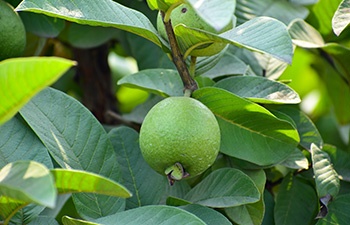
Native to the tropical Americas, the guava is a popular fruit in Florida for both commercial and home growers. Guava fruits are very nutritious, rich in vitamins A and C, and the seeds contain omega-3 and omega-6. It can be trained to grow as a small tree and may be planted anywhere in Florida that doesn’t experience prolonged freezes or waterlogged soils.
Characteristics
Guava (Psidium guajava) is a small single- or multi-trunked tree. While it can reach as tall as 20 feet, light annual pruning is recommended to keep the tree at eight feet or shorter. Leaves are oblong and three to seven inches long with pronounced veins and serrated margins. The bark is green or brown with a mottled pattern. Flowers are white and one inch in diameter.
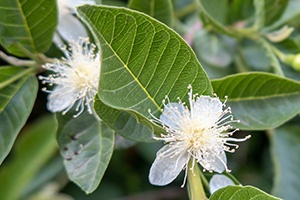
The guava fruit is a round or ovoid berry with small brown seeds and a green to yellow peel. Fruits can weigh anywhere from only an ounce to three pounds. Colors and flavors also vary greatly by variety. Peel colors can range from green to yellow, with the flesh being white, yellow, pink, or red. Some cultivars are quite acidic, while others are sweet.
Most guavas grown in Florida are either a pink/red type that are harvested when ripe or a white type that are eaten while still unripe. Popular pink cultivars include ‘Homestead’ (Ruby x Supreme), ‘Barbi Pink’, ‘Blitch’, ‘Hong Kong Pink’, and ‘Patillo’. Commonly available green varieties include ‘Crystal’, ‘Lotus’, ‘Supreme’, and ‘Webber’.
Planting and Care
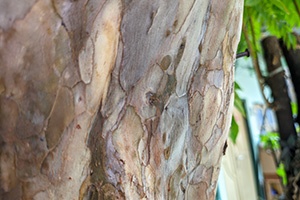
Guava’s ideal temperature for productivity is between 73–82 degrees Fahrenheit; growth slows when temperatures dip below 60. Mature trees can survive short periods of freezing weather, but damage may occur if the freeze is prolonged or temperatures reach 25. Young trees can die if they experience temperatures lower than 28. Plant guava in the warmest part of your landscape to help prevent cold damage, and keep in mind that the lowest areas of your landscape are typically the coldest.
Although guava can be propagated from seed, it’s not recommended since it won’t be “true” and fruit production may not begin for years. Commercially guava is propagated by air layering, stem cuttings, or grafting. Home growers should purchase container trees to plant. At the nursery, look for healthy trees that are two to four feet tall from the soil in a three-gallon container. Beware large trees in small containers, since they are likely root bound; compacted root systems are less likely to result in a healthy tree.
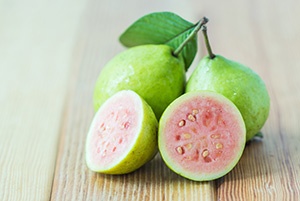
Plant the tree in a location with full sun. Guava can tolerate short durations of flooding, but areas that consistently flood should be avoided. It is also moderately tolerant of drought, windy conditions, and salt. Once you’ve identified your planting site, dig a hole that is three to four times the diameter and three times as deep as your tree’s container. Then backfill with some of the removed soil so that the tree will sit with its soil line is at or slightly above the soil around it. Remove the tree from its container and place in the hole. Fill in the rest of the space with the excavated soil.
If you’d like to add any topsoil or compost, mix it with the excavated soil at a ratio no higher than 1:1. Lightly tamp the soil around the tree roots and then immediately irrigate. If you live in a flood-prone area, planting the tree on a mound two to three high can help boost its chances of survival. Staking isn’t necessary, but if you choose to do so, use a natural material to tie the stake to the tree. Finally, apply a layer of mulch two to six inches deep around the tree to help retain soil moisture, reduce weed issues, and improve the soil structure. Keep the mulch eight to 12 inches away from the trunk.
Maintain a grass-free area at least two feet away from the trunk of the tree. Mowers, edgers, fertilizer, and irrigation used for lawn maintenance can be harmful for guava trees. Since the roots can extend beyond the drip line, don’t water or fertilize heavily near the tree.
Once your guava tree is planted, follow a maintenance schedule to ensure it thrives. In the UF/IFAS publication “Guava Growing in the Florida Home Landscape,” tables 2 and 3 outline which actions you should take each month of the year.
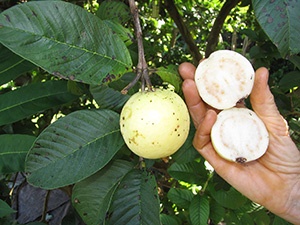
Guava has its fair share of pest and disease issues. Pests to watch out for include the Caribbean fruit fly, guava whitefly, red-banded thrips, guava fruit moth, and scales. Possible disease issues are anthracnose, red alga, and various leaf spots. If you notice any signs of pests or disease on your trees, contact the experts at your county Extension office for advice.
Start looking for fruits once your guava trees reach three to four years old. Typically, the main crop is produced in the summer and another smaller crop is harvested in early spring.
Pink or red guava are ready to pick when the peel turns light green to yellow. After harvesting, leave fruit at room temperature until they are fully ripened.
White guavas are ready when they are green to light green. Of course, there’s no ripening required since green guava are eaten before that. Once ripe, fruits can then be stored in the refrigerator for up to a week.
Status Change
It should be noted that guava has been reassessed since the publication of many UF/IFAS documents and is now listed as a “caution” plant for Central and South Florida on the UF/IFAS Assessment of Non-native Plants in Florida’s Natural Areas. This does not mean that it is invasive, but that it should be managed to ensure it does not escape the landscape.
Also on Gardening Solutions
More from UF/IFAS
- Guava Growing in the Florida Home Landscape (Note the outdated assessment status.)
- La Guayaba en Florida (en espanol)
